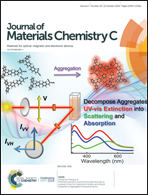Polarized resonance synchronous spectroscopy as a powerful tool for studying the kinetics and optical properties of aggregation-induced emission†
Abstract
Light scattering and absorption both contribute to the UV-vis extinction quantified with a UV-vis spectrophotometer, but they differ drastically in their causes and effects. The existing optical studies have generally focused on the fluorescence and total photon extinction of the aggregation-induced-emission (AIE) materials. The effects of aggregation on the light absorption and scattering of AIE luminogens (AIEgens) are essentially unexplored. Herein, we reported a spectroscopic study of the structures and properties of AIE aggregates using the combination of UV-vis, fluorescence, and polarized resonance synchronous spectroscopy (PRS2) methods. Optical activities including the light absorption extinction, scattering extinction, and absorbance-normalized fluorescence emission have been quantified for the first time for the AIE aggregates prepared with an in-house prepared AIEgen 2-((4-(diphenylamino)biphenyl-4-yl)methylene)malononitrile (TPMN). Absorption extinction dominates the entire UV-vis extinction spectrum obtained with the dissolved TPMN. For the UV-vis spectrum acquired with TPMN aggregates, however, scattering extinction accounts for up to 35% of the peak photon extinction at 480 nm. This number rises to 100% in the wavelength region beyond 580 nm. Sample incubation increases the light scattering extinction, scattering depolarization, and fluorescence emission of the TPMN aggregates, but reduces their light absorption extinction. With its ability to provide information inaccessible with the existing techniques, this work demonstrates that PRS2 is a powerful tool for AIE materials in quantifying their optical properties and monitoring their aggregation/disaggregation processes.

- This article is part of the themed collection: 20th Anniversary of Aggregation-Induced Emission


 Please wait while we load your content...
Please wait while we load your content...